Cool Mac Features You May Not Know About: Dictionary
![]() Mac owners might not be aware that a feature introduced in Tiger (OS X 10.4) is a built-in Dictionary and Thesaurus, based on the New Oxford American Dictionary (2nd Edition) and the Oxford American Writers Thesaurus. If you are aware of the app, you might not be fully familiar with the extent it is integrated into the system.
Mac owners might not be aware that a feature introduced in Tiger (OS X 10.4) is a built-in Dictionary and Thesaurus, based on the New Oxford American Dictionary (2nd Edition) and the Oxford American Writers Thesaurus. If you are aware of the app, you might not be fully familiar with the extent it is integrated into the system.
First, there is the app itself:
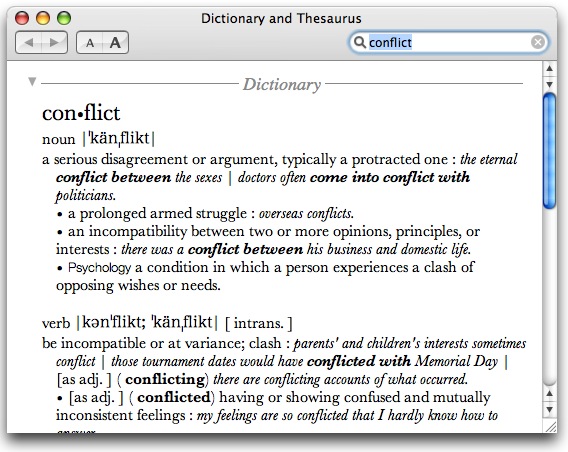
Its use is pretty much straightforward and self-explanatory. Of course, it is handy and convenient to have a complete and detailed dictionary app on hand, especially if it is a free one that comes with the OS. But you can access the dictionary in other ways as well. One is via the app’s Dashboard widget:
![]()
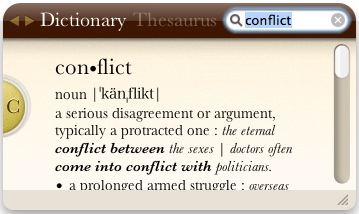
This might not impress you, however, as you may not be a Dashboard fan, and it is just as fast to open the Dictionary program directly, unless you use the Dashboard frequently or simply prefer it outright.
But there is at least one more way to access the dictionary app which is very, very cool. Apple made the decision to integrate the dictionary into the system, and allows for it to be applied “inline,” within any app written to accept it. Take Safari, for example. Let’s say that you want a definition of a word you see on a web page. You might expect that you would have to either type the word into the Dictionary app, or select and copy the word from the page, open the dictionary app, and paste it into the lookup box. Apple’s integration cuts that down to a simple keyboard shortcut.
Just type the shortcut Command-Control-D (you can customize that–I changed it to a simple F-key) while the cursor is floating over the word in question:
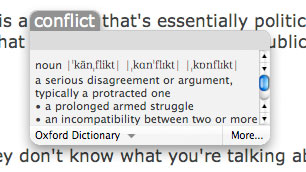
And viola, the definition pops up in a little inline window. Cool!
To get the thesaurus:
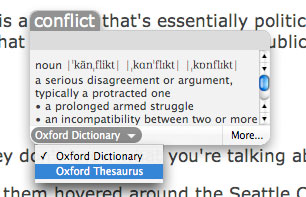
Select that, and you get:
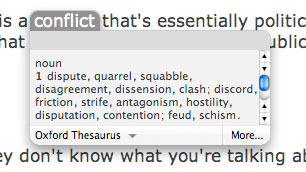
If you click on the “More…” button at bottom right, the Dictionary app will open to the word you selected.
As I mentioned, it will work in any app that is coded to accept the feature, which unfortunately means that any app written before Tiger was released might not allow it to work (e.g., Microsoft Word 2004–though that particular app has its own built-in dictionary).
Where it is written in, it is a great feature, executed beautifully by Apple. My blog editor (Ecto) allows it to work, and I use it constantly, particularly the thesaurus element–very helpful when I have used the word “dishonest” too many times when writing about Bush, for example, and I need other ways to say the same thing.
FYI: fraudulent, corrupt, swindling, cheating, double-dealing; underhanded, crafty, cunning, devious, treacherous, unfair, unjust, dirty, unethical, immoral, dishonorable, untrustworthy, unscrupulous, unprincipled, amoral; criminal, illegal, unlawful; false, untruthful, deceitful, deceiving, lying, mendacious; informal: crooked, hinky, shady, tricky, sharp, shifty; literary: perfidious.

I have 0SX and I cannot get a thesaurus to come up no matter what I do. I need a thesaurus and as far as I am concerned Mac has made it almost impossible. I followed the directions on this site to a T and can find no such animal.
Neil: Hmm… it’s on my Mac and every Mac I’ve tried it on.
Try this: Open the Dictionary application. Go to the “Dictionary” (main app) Menu, and open “Preferences.” In the prefs, there is an option to turn on and off the dictionary and thesaurus. My guess is that somehow your thesaurus got turned off.
Let me know if that works.